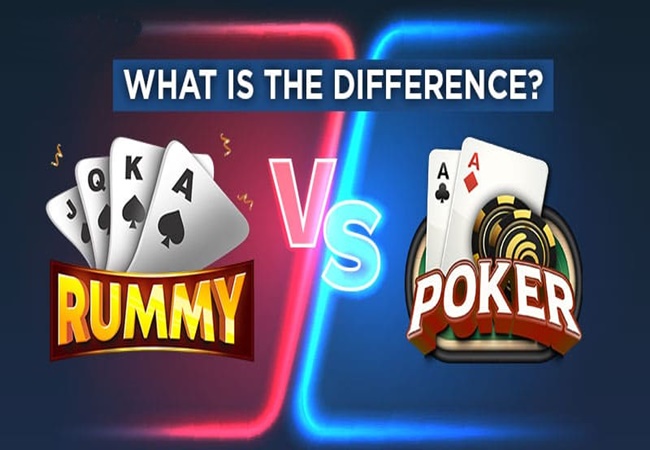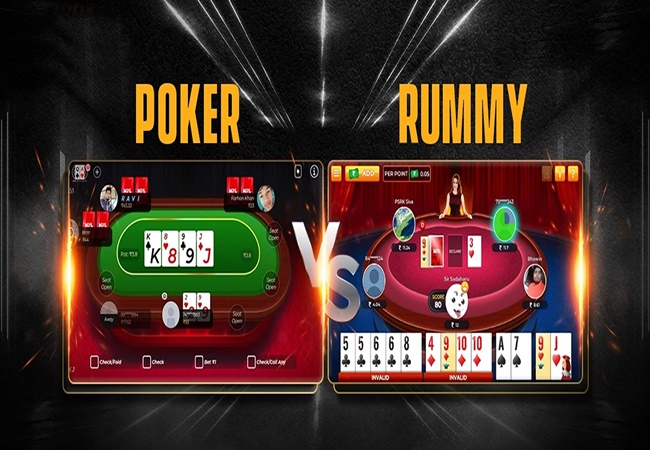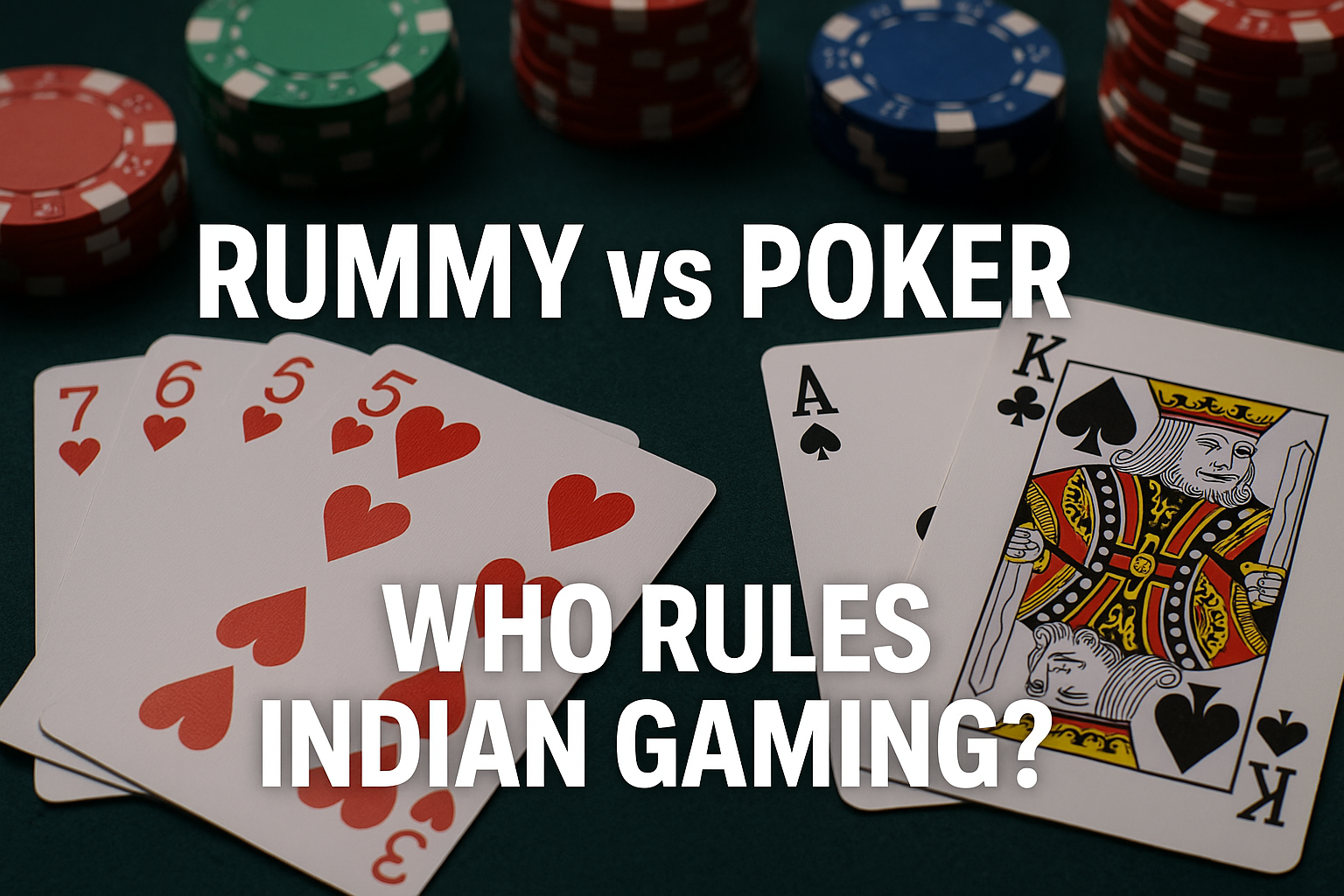Rummy vs Poker: Which Game Dominates Indian Online Gaming
India’s online gaming landscape has experienced explosive growth in recent years, driven by increasing internet penetration, the popularity of smartphones, and a shift in entertainment preferences among youth. Two of the most widely played card games—Rummy game and Poker—stand out as major contenders in this booming industry. Both games have carved a significant niche in the Indian online gaming market, attracting millions of players across age groups and regions. But which one truly dominates? Let’s dive deep into a comparative analysis of Rummy vs Poker in the Indian context.

Understanding the Games
Rummy Game: A Cultural Staple
Rummy is a traditional card game that has been part of Indian households for decades. Played with 2 to 6 players, the objective is to form valid sets and sequences from the cards dealt. The most popular version in India is 13-card Rummy game, where players aim to create at least two sequences, one of which must be a pure sequence, without using a Joker.
Rummy game has a strong cultural association in India, often played during family gatherings and festivals like Diwali. This familiarity gives Rummy a natural advantage in terms of reach and acceptance.
Poker: The Strategy Game
Poker, particularly Texas Hold’em, is another major player in the online card gaming scene. Unlike Rummy, Poker works involves betting and bluffing, with the goal of creating the best five-card hand or outsmarting opponents into folding. While Poker originated in the West, it has gained immense traction in India, especially among young adults and professionals.
Though traditionally associated with gambling, the skill-based nature of Poker has allowed it to establish a legal and social foothold in many Indian states.
Legal Landscape
The legality of both Rummy game and Poker has a significant impact on their growth in India. Indian courts have recognized Rummy as a game of skill, allowing it to operate legally in most parts of the country. Similarly, Poker has been recognized as a skill-based game in states like West Bengal, Nagaland, and Karnataka. However, several states still maintain a conservative stance toward Poker due to its association with gambling.
This legal ambiguity slightly tilts the balance in favor of Rummy, which enjoys broader legal recognition and fewer restrictions.
Player Demographics
Rummy’s Player Base
Rummy game appeals to a wide demographic, from homemakers and middle-aged professionals to retirees and casual players. Its straightforward rules and nostalgic value make it accessible to people who may not consider themselves “gamers” in the traditional sense.
The gender divide is also relatively balanced in Rummy game, with platforms like Junglee Rummy and RummyCircle reporting increasing participation from female players.
Poker’s Emerging Audience
Poker, on the other hand, attracts a younger, more urban audience. The majority of Poker players are men in the 21–35 age group, often from metros and tier-1 cities. This group is drawn to the strategic, competitive, and often lucrative nature of Poker, with many seeing it as a side hustle or even a professional pursuit.
Online tournaments with large prize pools have elevated the profile of Poker, creating opportunities for serious players and content creators.
Game Complexity and Learning Curve
One of the defining differences between Rummy game and Poker is the complexity and learning curve.
- Rummy game is easier to learn and quicker to master. Most new users can get the hang of the game within a few rounds. This makes it ideal for casual gamers or those looking for short bursts of entertainment.
- Poker, however, has a steeper learning curve. Players must understand hand rankings, betting strategies, reading opponents, and bluffing. While this makes Poker more engaging for strategic minds, it may intimidate new or casual users.
This difference influences how long players stick with the game and how much time and money they are willing to invest.
Online Presence and Platforms
Several leading Poker apps and gaming platforms in India offer both Rummy and Poker:
- Rummy game platforms: RummyCircle, Junglee Rummy, Adda52 Rummy
- Poker platforms: PokerBaazi, Spartan Poker, Adda52 Poker
In terms of sheer volume, Rummy game platforms have historically had a larger user base. However, Poker platforms have seen higher average transaction values due to bigger tournaments and high-stakes games.
The integration of gamification elements, loyalty rewards, and real-money gameplay has further boosted engagement on both types of platforms.

Revenue and Monetization
When comparing monetization potential, Poker typically brings in higher revenues per user. The presence of buy-ins, rakes, and high-stake tables makes Poker more lucrative for operators. Professional players and influencers often endorse Poker as a viable income stream, especially for those who understand its nuances.
Rummy game, while having a broader reach, tends to generate revenue through volume. With lower stakes and faster games, operators rely on high user engagement and frequent gameplay to drive earnings.
According to reports, the Indian real money gaming market crossed ₹13,000 crores in FY2024, with Rummy and Poker being the top contributors.
Competitive Scene
Rummy Tournaments
Rummy game has numerous daily, weekly, and festive tournaments with varying prize pools. However, the competitive scene is relatively low-profile, with less media coverage and fewer celebrity endorsements.
Poker Tournaments
Poker has a thriving tournament scene in India, with major events like the India Online Poker Championship (IOPC), Poker Sports League (PSL), and World Series of Poker (WSOP) India. These tournaments often feature massive prize pools, sometimes reaching crores, and are live-streamed to large audiences. Influencers, streamers, and even Bollywood celebrities have lent their support, increasing Poker’s visibility and prestige.
Social and Psychological Appeal
- Rummy offers relaxation, nostalgia, and quick fun—an ideal break from daily stress. Its social and family-oriented image appeals to a wider audience.
- Poker provides mental stimulation, competition, and the thrill of strategic depth. It’s more appealing to those who enjoy analysis, probability, and risk-taking.
This psychological distinction affects user engagement, with Rummy players often playing for casual fun, and Poker players on Poker sites logging in with a more focused, goal-oriented mindset.
The Verdict: Who Dominates?
While both Rummy and Poker have made indelible marks on the Indian online gaming industry, Rummy currently holds a slight edge in terms of mass appeal, legal clarity, and platform penetration. Its cultural relevance and accessibility ensure a broader user base.
However, Poker is catching up quickly, especially among the youth. Its strategic depth, glamorized tournaments, and higher earning potential give it a distinct edge in long-term engagement and monetization.
Ultimately, the question isn’t necessarily which game dominates, but rather how both games are coexisting and complementing each other in the evolving Indian online gaming space. As more states clarify gaming laws and as younger players seek new challenges, the scales may continue to shift.
Conclusion
Rummy and Poker are two sides of the same coin in India’s online card gaming revolution. Each caters to a different kind of gamer—Rummy to the nostalgic, casual player, and Poker to the competitive, strategic thinker. While Rummy dominates by numbers today, Poker is steadily gaining ground in terms of visibility, innovation, and professional opportunities. In the end, the Indian gaming market is big enough for both to thrive—and for players to enjoy the best of both worlds.

5 FAQ’s: Rummy vs Poker
1. Which game is more popular in India—Rummy or Poker?
Rummy currently holds a larger player base in India due to its cultural roots, simpler rules, and wider legal recognition. However, Poker is growing rapidly among younger, urban audiences.
2. Why is Rummy more widely accepted in Indian households?
Rummy has been played in Indian families for generations, especially during festivals like Diwali. Its familiarity and simpler gameplay make it appealing across all age groups.
3. What makes Poker attractive to Indian players?
Poker’s appeal lies in its strategic depth, competitive tournaments, and potential for high earnings. Younger players and professionals are especially drawn to its challenge and prestige.
4. Are both Rummy and Poker legal in India?
Yes, both are considered games of skill and are legally allowed in several states. Rummy enjoys broader legal clarity, while Poker faces restrictions in some regions due to its gambling perception.
5. How do Rummy and Poker differ in monetization and engagement?
Rummy generates revenue through high volumes of casual play, while Poker earns more per user thanks to buy-ins, rakes, and high-stakes tournaments.







